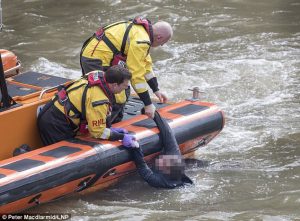Westminster Bridge jump woman rescued (a week later), and Fire boat on drill shock
And so, as reported at FBEL in the previous article, since the Westminster Bridge incident – where we are told he sustained an injury to his foot/leg – Andrei Burnaz has been seen in public; and the author hopes that the reader is as glad as he was to see him looking in rude health. Unfortunately, there is still no news of Andreea Cristea, Andrei’s girlfriend, and the woman who we are told fell off of Westminster Bridge. Naturally, because a whole nation was encouraged to be touched by this couple’s predicament (what with their impending nuptials, and all), and to be concerned for her well being, FBEL too is wondering about her injuries, and the state of her recovery (especially since discovering she was in a coma – see abovementioned article). In fact, such was the unease that it has prompted a revisit to a topic initially broached in the first article at FBEL about the Westminster Bridge incident (which can be read here).
Let’s start with a few facts, and for many people the BBC is the authority (and not Fake News), so let us measure by its gauge. On an infographic published by that august body of integrity, it tells us that at 14:40:18, on the 22nd March 2017, the car supposedly driven by a man named “Masood” that “sped” northbound across Westminster Bridge “hits [a] group [of people] and [a] woman falls”. Fortunately this plunge is captured by a camera that, by the direction of its scope, must have been placed on the Millbank Tower* situated further west along the river.
The author was looking for tide timetables, and could only find one for Putney Bridge, which said that on the day of the incident, at the time stated above, the river was minutes away from the fullest extent of the low tide, meaning that the woman in the river would have been carried downstream, and to the location from whence she was eventually said to have been rescued. The author doesn’t have enough information to understand the strength of the current.
It seems that this woman was unconscious in the water pretty much from the start of her misadventure – a witness told RT (source) that he saw a body floating face down, and the impression he gives is that it was one of the first visual prompts he received to tell him that something abnormal had happened. We could definitely understand this state of affairs had she been struck by the vehicle, but the author previously concluded that the best explanation for what is shown in the footage is a person, we are told a woman, who had climbed over the rail, and then had leapt of her own accord. This conclusion was arrived at by noticing how the descent appears to begin after the car has driven past the point of its commencement, and how there is a horizontal force component in the trajectory of the woman as she plunges into the river below. It has to be said, the corporate-media has never committed to a definitive explanation, but instead when dealing with the matter often presents two options: either she was pushed by the car, or she leapt in to avoid it.
There is a clue in the video footage that confirms the time for the specific moment of the fall given by the BBC, and this is the appearance of the Thames Clipper apparently moving between the Westminster side of the river and the London Eye. The company timetable (the October 2016 version, now superseded from April 2017, but still available on the web) states that the westbound service had a 14:39 departure time for the Westminster Pier, and a 14:45 departure time at the London Eye pier, where the service terminated. The eastbound service had the same times at the same places, suggesting that the westbound turned into the eastbound to then depart from Bankside at 14:55. This could be important information, because in a film that purports to show the woman being rolled out of the river by a Fire Rescue vessel (please view it on the Mail page in which it is embedded: here), the Thames Clipper cannot be viewed at the London Eye pier. In other words, this rescue is taking place after 14:45, meaning by the time it is being recorded on film the woman has spent nearly 5 minutes in the water.
There were other images (also viewable on the abovementioned Mail article, as well as the first FBEL article) that showed that it was the City Cruises flag ship, Millennium Diamond, involved in mounting a rescue in the first instance. This was confirmed by the river cruise company in question:
Kyle Haughton, Managing Director at City Cruises said: ‘City Cruises’ Millennium Diamond was in the area of the incident at the time and worked alongside London’s emergency services to support in the rescue efforts of a woman in the water: once alerted by people on the bridge, the ship’s Captain reacted fast on spotting her, he halted the boat in order to hold her out of the water and stop her from being carried any further by the current.
‘The emergency services were called immediately and arrived within minutes to take over the rescue operation.
From this we discover that the Millennium Diamond spotted the woman first. The City Cruises timetable (Sep 2016 to May 2017) suggests that a boat was due to depart the London Eye pier at 14:50, so if the flagship of the fleet is used in such a routine way (rather than purely being a charter boat, which is the impression that the author gets), the timetable suggests that the boat came across the woman as it was adhering to this departure time. And in that case, it could be that the rescue did not begin until minutes or seconds approaching 14:50.
City Cruises reported that it took “minutes” for the Fire Rescue boat to arrive – which then appeared to take quite a lot of trouble to manoeuvre the woman into a scoop. Please look at the images of this in the Mail article. At first the Fire boat is parallel to the river bank – we can tell because of the white cruise boat in the background, which is on the Westminster side of the river. When we see the Fire boat crew positioning the woman into a scoop on the side of the vessel, it has been turned across the river so that it is perpendicular with the bank. In the first frame of the film, the boat is again parallel, and notably, the woman is in the scoop. The author has seen a report that the woman was finally retrieved from the water “just before 3pm”, and can well believe it from observing the palaver performed by the crew of the Fire service boat – which is discussed below.
From the still images already mentioned we can tell that the woman is unconscious at time of rescue, and written reports in corporate-media bear this out. This means that the woman may have spent nearly 20 minutes in the water, and may have been unconscious for all of that time. We can probably definitely say that she spent at least 5 to 10 minutes in the water until efforts were afoot to rescue her. We can very likely say that she spent a matter of minutes after that being unconscious while the Fire Rescue boat arrived. If the author has to be frank, he was surprised to hear that this woman had been taken out of the water alive. Indeed, the following is a caption from one of the pictures in the above linked-to Daily Mail article (emphasis added): “A fire services boat is launched to help a City Cruises crew rescue Ms Cristea’s body from the River Thames”. Then there’s also this in the main body of the article: “But despite her harrowing ordeal she managed to survive the attack after a City Cruises crew spotted her body floating downstream”.
Bear this in mind as we now look at the effectiveness of the rescue. Guidance to civilians for rescuing people from water talks about a necessity for a rescuer to enter the water to extract an unconscious victim. This seems to be intuitive as there would be an urgent requirement to perform CPR. Delays to doing this are crucial in terms of determining whether or not a victim suffers serious injury, and by what degree, and it occurs to the author that messing about with poles and scoops might not provide as timely an intervention as a man on a rope would. Having looked into similar cases before, the author very much suspects that company and government regulations adhere to the “stand-on-the-bank-let-them-drown” culture that seems to have been cultivated in the British emergency services these past 30 years. Be that as it may, there is a Lifeboat on the Thames, and it has a low deck so that crew can reach into the water to extract people from it. The author was also concerned to notice that when in the scoop, the woman’s head is drooping backwards and clearly not supported, and also wonders if it is feasible for the unconscious state of the woman to have been caused by an impact with the water whereby an injury was also sustained to the neck. Admittedly, the author can’t judge whether or not the equipment used for the “rescue” might not be adequate in terms avoiding the exacerbation of any injury, but can’t help but wonder, generally, if the equipment is actually meant for retrieving dead bodies.
It is important to notice that we don’t have an image of the woman being positioned exactly in the scoop, and thus there is no visual conformation that the object on the end of the poles in the still images is the body in the scoop in the film of her rescue. In the first frame of the film she is already in place, and seemingly not submerged but resting on top of the water. Furthermore, there is a point in the film where the camera operator, after zooming in on the body as it is lifted clear of the water, inexplicably pans away from the rescue attempt and the screen is filled with the Thames and some of the hull of the boat. Previous experience suggests that when, during coverage of events which count on sleight of hand to fool an audience, this “cameraman’s droop” occurs, then there is something going on that we’re not meant to see. The author did notice that there is something very odd with the hair on this rescued body. Long hair, when wet, sometimes sticks to the face, but in this case it all falls neatly and vertically downwards. Of course, the accidental way that hair falls when lifted out of water is no indicator of anything. But, the author also noticed that the hair doesn’t appear to hang down from the head in the same kind of abundance when the body was raised so that it shifted to lay on its side. While, the author remains reluctant to jump to an accusation that this Fire Rescue boat had a dummy in its scoop, and was filmed emulating a rescue – which could have occurred at any time; note the City Cruises vessel is not in the film footage – there is a crucial piece of information that now comes to light to tempt it (actually, the information was sitting in the corporate-media reports unnoticed by the author until now). This is from the same Daily Mail article from whence comes all the other material previously cited (again, note the tendency to refer to a body rather than a person):
The staff, on the Millennium Diamond pleasure boat, could not fish her body out of the water but thankfully managed to alert a fire service boat on a ‘realisation exercise’ nearby.
This is very significant. The Fire Rescue vessel was in the vicinity doing a drill. And so, it was presumably sent to the scene by a central controller that had received the alarm from the crew of the Millennium Diamond and, with proximity being the rationale for doing so, sent instead of any other vessel, including a Lifeboat, to deal with the object in the water, so that the civilian vessel could hand over to the authorities without thinking any more of it. Crucially for the conjurors who stage false flags, people observing this rescue through corporate-media reports could potentially be fed imagery of this boat on exercise and conflate it with the story of the rescue of the woman who had fallen from the bridge. It is a remote possibility, but it is much too early to declare it anything more than that.
 In the meantime – and to finish – we’ll content ourselves with covering another story about a woman who was fished out of the Thames on the 29th March. This happened a few hours before there was going to be a commemoration of the “terror attack” of the week before. A Daily Mail article informs us that a Lifeboat (see above image) was on hand to extract the woman who would be “dealt with under the Mental Health Act” – interesing in itself. The report also tells us that the police were not treating the incident as suspicious, but that shouldn’t stop us from doing the same. Terror incidents are to be exploited by the Establishment as fully as possible, and this includes hitting the same nerve over again. And then sometimes there might be a need to tie up loose ends by encouraging the forging of associations in the public consciousness between the terror incident and what might seem to the alert and awake to be totally unrelated events. The very least this new incident can teach us is that, if they want to, the authorities can get the Lifeboat on scene at Westminster Bridge to whip someone out of the drink before there are any tears.
In the meantime – and to finish – we’ll content ourselves with covering another story about a woman who was fished out of the Thames on the 29th March. This happened a few hours before there was going to be a commemoration of the “terror attack” of the week before. A Daily Mail article informs us that a Lifeboat (see above image) was on hand to extract the woman who would be “dealt with under the Mental Health Act” – interesing in itself. The report also tells us that the police were not treating the incident as suspicious, but that shouldn’t stop us from doing the same. Terror incidents are to be exploited by the Establishment as fully as possible, and this includes hitting the same nerve over again. And then sometimes there might be a need to tie up loose ends by encouraging the forging of associations in the public consciousness between the terror incident and what might seem to the alert and awake to be totally unrelated events. The very least this new incident can teach us is that, if they want to, the authorities can get the Lifeboat on scene at Westminster Bridge to whip someone out of the drink before there are any tears.
*Coincidentally, this footage appears to have been generated by the BBC, or it obtained some kind of right of ownership, because when other outlets have used it, the state-broadcaster receives an attribution. It appears to have been taken from the roof of Millbank Tower, and the author would like to know if the BBC has a camera permanently stationed there, or has to assign a cameraman to the location whenever it needs footage.



















One stinky fishing incident. Great article.